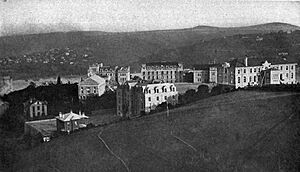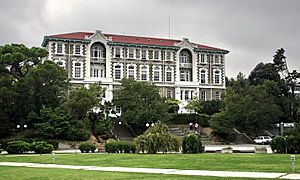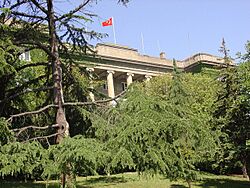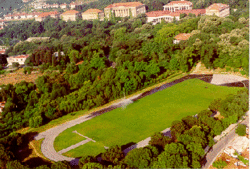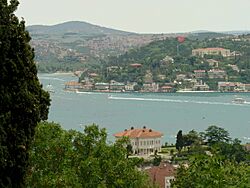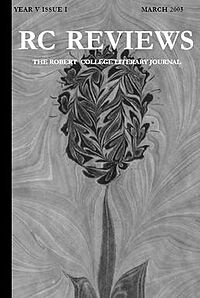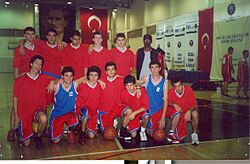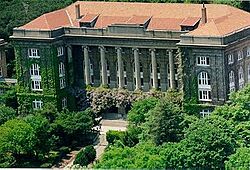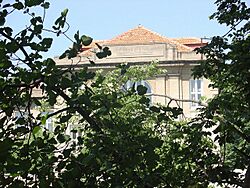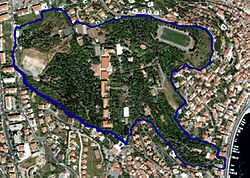Robert College facts for kids
Quick facts for kids Robert CollegeRobert Kolej
|
|
|---|---|
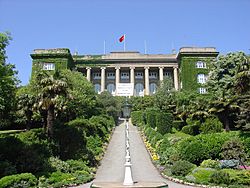 |
|
| Address | |
|
Kuruçeşme Cad. No. 87
Arnavutköy, Beşiktaş, Istanbul
Turkey
|
|
| Information | |
| Type | Independent, day & boarding |
| Established | 1863 |
| Founder | Christopher Robert and Cyrus Hamlin |
| CEEB code | 696220 |
| Headmaster | Adam Oliver & Nilhan Çetinyamaç |
| Grades | Prep, 9–12 |
| Gender | Co-educational |
| Enrollment | 1,045 190 boarding 276 on scholarship |
| Language | English, Turkish |
| Campus size | 265 acres (107 ha) |
| Campus type | Urban |
| Houses | Gould Hall, Mitchell Hall, Woods Hall, Sage Hall, Bingham Hall, Feyyaz Berker Hall, Suna Kıraç Hall, Nejat Eczacıbaşı Hall |
| Student Union/Association | Robert College Student Council |
| Color(s) | |
| Mascot | Bobcat |
| Team name | Bobcats |
| Accreditation | NYSAIS |
| Newspaper | Bosphorus Chronicle |
| Yearbook | Record |
The American Robert College of Istanbul (Turkish: İstanbul Özel Amerikan Robert Lisesi or Robert Kolej [ˈɾobæɾt koˈleʒ]), often abbreviated as Robert or RC, is a highly selective, independent, co-educational, private high school in Turkey. The school is situated in a 265-acre (107 ha) wooded campus on the European side of Istanbul in the Beşiktaş district, with the historic Arnavutköy neighborhood to the east and the upscale Ulus neighborhood to the west. Founded in 1863, Robert College is the oldest continuously operating American school outside the United States.
Robert College is consistently ranked as the top private high school in Turkey. The school has a long list of notable alumni, including scientists, entrepreneurs, politicians, journalists, artists, three Turkish prime ministers, four Bulgarian prime ministers, multiple members of the Turkish cabinet, Nobel laureate Orhan Pamuk and philanthropist Osman Kavala. Robert College is a member of the G30 Schools group, and is accredited by the New York State Association of Independent Schools.
Contents
History
In 1863, Robert College was founded in Bebek by Christopher Robert, a wealthy American philanthropist, and Cyrus Hamlin, a missionary devoted to education. Six years after its foundation, with the permission (Ottoman Turkish: irade) of the Ottoman Sultan, the first campus (currently housing Boğaziçi University) was built in Bebek at the ridge of the Rumeli Castle. At the time, the school was very close to a Bektashi tekke, whose leaders maintained an excellent relationship with the Congregational and Presbyterian founders of Robert College, according to Friedrich Schrader, a German lecturer at Robert College during the 1890s. Hamlin, who became the first president of Robert College, was preoccupied with the construction of the campus such that George Washburn acted as the de facto head of the college from 1871 onwards. In 1877, he was officially named president by the trustees. During his tenure between 1877 and 1903, Washburn "gradually assembled a faculty of distinguished scholars who firmly established the college's academic reputation."
Christopher Robert died in 1878, leaving a significant portion of his wealth to the college. In that same year, a college catalog was compiled, providing general information and an outline of the courses of study. Defining the aims of the college, the catalog stated: "The object of the College is to give to its students, without distinction of race or religion, a thorough educational equal in all respects to that obtained at a first-class American college and based upon the same general principles."
After Washburn, Robert College was administrated by Caleb Gates (1903–1932). During his presidency, the student body of the school underwent a major demographic transition; whereas the student body previously consisted of Bulgarian, Romanian, and other Christian minorities in the Ottoman Empire, the Young Turks' liberalization of policies directed towards foreign schools and an increasing demand amongst Turks for a western education resulted in considerable numbers of Turkish students enrolling. Founded at the time of the Ottoman Empire as an institution of higher learning serving the Christian minorities of the Empire as well as foreigners living in Constantinople, the school adopted a strictly secular educational model in accordance with the republican principles of Turkey in 1923. Robert College, at various points of its existence, had junior high school, high school, and university sections under the names Robert Academy, Robert Yüksek and American College for Girls. Since 1971, the current-day Robert College has functioned only as a "high school" (more comparable to the French lycée in academic rigor) on its Arnavutköy campus (formerly the campus of American College for Girls), yet it retains the title of "College". The Bebek campus and academic staff were turned over to the Republic of Turkey for use as a public university named Boğaziçi University, the renamed continuation of Robert College's university section.
Major events
- 1863, September 16: Robert College opened with 31 students at Bebek Seminary School.
- 1922: President Caleb Gates and Hüseyin Pektaş (the first Muslim graduate and then vice-president of the college) attended the Conference of Lausanne representing foreign educational institutions in the Ottoman Empire.
- 1932: With Paul Monroe, the joint presidency system was adopted by Robert College (RC) and the American College for Girls (ACG). Robert Academy was the preparatory school for Robert College, which had a reputable engineering school. Instruction was bilingual, in Turkish and English.
- 1957: Robert College was granted permission to become an institution of higher learning by the Republic of Turkey; Robert College Yüksek provided university-level instruction and is the precursor of the current Boğaziçi University. Robert Academy remained on the Bebek campus as a private high school.
- 1971: Robert College Yüksek officially closed on 18 May and was renamed Boğaziçi University. The merger of the American College for Girls and Robert Academy as a co-educational private institution with junior high and high schools, on the Arnavutköy campus was officially confirmed in September 1971. Robert College's Bebek campus was donated to the Republic of Turkey. Boğaziçi University was established as a public university on this land.
- 1998: With the adoption of a law calling for eight years of uninterrupted primary education in Turkey (junior high school would now be a part of primary education), the school stopped accepting students to its junior high school section.
- 2004: The last junior high school students graduated and the school's junior high school section was officially closed. Now, Robert College has Prep, 9th, 10th, 11th, 12th grades, and accepts students who have finished compulsory primary education of eight years.
List of presidents and heads
| Heads of Robert College | |||
|---|---|---|---|
| Head | Years of service | ||
| Cyrus Hamlin | 1863–1877 | ||
| George Washburn | 1877–1903 | ||
| Caleb Frank Gates | 1903–1932 | ||
| Paul Monroe | 1932–1935 | ||
| Walter Livingston Wright | 1935–1943 | ||
| Harold Lorain Scott (acting president) | 1943–1944 | ||
| Floyd Henson Black | 1944–1955 | ||
| Duncan Smith Ballantine | 1955–1961 | ||
| Harold Locke Hazen (acting president) | 1961 | ||
| Patrick Murphy Malin | 1962–1964 | ||
| James L. Brainerd (acting president) | 1965 | ||
| Dwight James Simpson | 1965–1967 | ||
| Howard P. Hall (acting president) | 1967–1968 | ||
| John Scott Everton | 1968–1971 | ||
| John Clay Chalfant | 1971–1977 | ||
| James Richard Maggart | 1977–1981 | ||
| Elizabeth Dabanovitch (acting head) | 1981–1982 | ||
| Alan Donn Kesselheim | 1982–1984 | ||
| Margaret A. Johnson | 1984–1988 | ||
| Harry A. Dawe | 1988–1992 | ||
| Benjamin D. Williams III (interim head) | 1992–1993 | ||
| Christopher Wadsworth | 1993–2001 | ||
| Livingston Merchant | 2001–2005 | ||
| John Russell Chandler | 2005–2012 | ||
| Anthony Jones | 2012–2015 | ||
| Charles H. Skipper | 2015–2019 | ||
| Adam Oliver | 2019–present | ||
Academics
As of 1999[update], as per Turkish Ministry of National Education (MEB) regulations, Turkish is the instructional language of history and social studies classes.
Students
Robert College accepts 180 to 220 students each year, who have scored within the top 0.2 percentile in a nationwide examination, which every Turkish student must take in order to study in a high school (secondary education) after they complete their primary education. The school has around 1000 students each academic year.
In the 1998–1999 academic year there were 942 students, with 99% having Turkish nationality.
Circa 1904, the school had about 300 students, with boarding space for about 200. Lucy Mary Jane Garnett wrote in the 1904 work Turkish Life in Town and Country that at that time most of the students were Christian as the college had a requirement for students to attend Christian Sunday church services and chapel services, and "it would be unsafe for any professed Moslem to become either a resident or a daily student" since the Ottoman government would take a dim view of a Muslim going to chapel. In 1904, Greek students made up the majority and other students included significant numbers of Armenians and Bulgarians.
Faculty and staff
The faculty have an average of 20 years of teaching experience and the majority have either Turkish or United States citizenship. The school currently has faculty who are 50% Turkish, and 48% native English speakers (including faculty from English-speaking countries other than the United States). Sixty percent of the full-time faculty hold master's degrees or higher.
As of 1999[update] there were 102 teachers, with 45% being Turkish and 32% being American. Of the teachers, eight were part-time. The school's guidance counselors, as of that year, were English-speaking Turkish citizens.
As of 1999[update], as per Turkish Ministry of National Education regulations, the school employs only Turkish citizens to teach history and social studies classes.
As of 1999[update], the school pays its foreign employees funds so that their children may attend Istanbul International Community School. If an employee chooses another school, Robert College will pay an equivalent amount.
In 1904, the faculty included Americans, Turks, Armenians, Bulgarians, and Greeks.
Curriculum
Robert College is a five-year high school, with the first year (Prep) being the English immersion year that prepares students for rigorous curriculum, which is mostly in English. English is the language of instruction used in Science, Mathematics, Literature, Physical Education, Art and Music courses. Turkish is the required language of instruction in social sciences and Turkish language/literature.
Higher education
Robert College graduates traditionally continue their education in the United States or Turkey, though in recent years the number of students studying in Canada and the United Kingdom increased. Every year, approximately 50–60 percent of the graduating class choose to study abroad, while those wishing to study in Turkey get placed in a university based on their score on the Core Proficiency Test-Advanced Proficiency Test (TYT-AYT). In 2006, Robert College ranked first in all three sections of ÖSS, a formerly-administered Student Selection and Placement System test, among private high schools in Turkey, with 76 out of 132 students taking the exam scoring in the top 0.3% (top 5000). Out of the 104 students who chose to study in Turkey, 29 were admitted to Boğaziçi University, which is the overall highest ranking school in Turkey. 56 students chose to continue their education abroad and 36% of these students are attending Ivy League colleges. In 2011, Robert College placed 123 graduates in Turkish universities, 21 of them, 40%, in Boğaziçi University. Another 53 planned to study abroad, 8 (15%) in the Ivy League. Of the 79 students who had applied abroad, 75 were offered admission.
Co-curricular activities
Robert College has about 100 student activity clubs as of 2015. Robert College introduced basketball to the Ottoman Empire in 1907. The first Student Council in Ottoman Empire was also formed in 1908 in Robert College.
Student Council
Student Council is formed of a group of annually elected student governors and a faculty advisor. The elected body is proportional with class size. As well as class representatives, the president, the vice president, the secretary and the treasurer are elected after a period of campaigning. Student Council is responsible for facilitating communications between students, faculty and administration, as well as organizing social activities and fundraising for clubs. Student Council also organizes the largest and oldest high school festival, Fine Arts Festival, in Turkey. The President of the Student Council, representing the student body, makes a speech during the opening, closing, and graduation ceremonies.
Publications
English
- Bosphorus Chronicle: The school's newspaper published quarterly (first published in 1959).
- Record: The Yearbook.
- Kaleidoscope: The English literature magazine.
Turkish
- Köprü (The Bridge): The school's Turkish newspaper, published bimonthly (first published in January 2009).
- Martı (Seagull): Turkish literature journal.
- Oda (Room): Turkish literature journal publishing poems, stories and photos submitted by students.
- Tarih (History): The History Club's annual publication.
- Sinek (Fly): The Film Review Club's annual publication.
Conferences and festivals
Fine Arts Festival (FAF)
The Fine Arts Festival is the largest secondary school festival in Turkey. It has been held annually since 1982 by the Robert College Student Council. Each year, more than 2,000 people attend the festival, which is traditionally held in May. The festival is a big event in which many student groups can perform on stage. There are various art exhibitions and dance shows that also take place. Student Council members visit other high schools in Istanbul and advertise for this event. At the end of the festival, a well-known artist or band typically performs on stage. Most of the revenues used to fund this event are raised through food and ticket sales. Food vendors are usually selected by Student Council members and consist of restaurants close to Robert College such as "kumpir" sellers in Ortaköy. This promotes the tight-knit Robert College community spirit.
International Istanbul Youth Forum (IYF)
The International Istanbul Youth Forum is an annually held conference at Robert College. It has been organized every year since 2006 with participants from numerous European countries. Each year, more than 150 participants from all over Europe gather at the RC campus. The conference is organized by the Robert College European Youth Club.
Ethics Forum
Robert College Ethical Values Club organizes an ethics case study contest at national level among high school students, following their forum. The results are announced at the Ethics Conference near the end of the year. Both events attract more than twenty public and private schools from around Turkey.
Robert College International Model United Nations (RCIMUN)
Robert College International Model United Nations (RCIMUN) is a THIMUN-affiliated Model United Nations conference organized annually by the Robert College Model United Nations Club (RCMUN) since 2006. The conference includes four General Assembly committees, those being the Political, Human Rights, Environment, and Disarmament Committees, a Special Conference committee, the Security Council of UN, an Advisory Panel, ECOSOC, Specialized Agencies (RCSA), the equivalent of two intertwined historical committees which simulate a single historical event, a separate Historical Security Council, as well as a simulation of the International Criminal Court. Approximately 750 students, of which about 42% were from international schools attended the 2012 conference.
Istanbul Gençlik Forumu (IGF)
Istanbul Gençlik Forumu is a national conference where representatives from over 30 high schools from different regions come together to discuss issues regarding the future of Turkey. In 2008, the fifth IGF welcomed over 250 participants. Discussions about international affairs are held in Turkish and each committee is responsible for writing a resolution. Then, at the General Assembly, each resolution is discussed and voted on. It is also the National Selection Conference of EYP Turkey, which is also recognized by the international office of European Youth Parliament. The conference is held annually and is organized by the Robert College European Youth Club.
Turkish Theater Festival (TIFES)
Organized by the Robert College Theater Club, TIFES is one of the major theatrical events at high school level in Turkey. The festival takes place in Robert College campus during the first week of June. Numerous plays are put on stage during the week in Suna Kıraç Hall and famous actors, actresses and playwrights give talks on topics related to theatrical arts.
Junior Achievement Robert College Conference (JARC)
Robert College Junior Achievement Club is hosting this event. About 300 Junior Achievement students from all over Turkey meet each other and share their experiences with others and entrepreneurs and artists related to the topics like Risk (2010), Alternative Careers (2009), Creating a Brand (2008).
Eurasian Schools Debating Championship (ESDC)
The Eurasian Schools Debating Championships (ESDC) is an annually organized, WSDC-style debating tournament, that welcomes high school students representing a wide range of countries. While being the only student-run, high school level debating organization, it has gained a reputation as one of the best WSDC-style tournaments worldwide. With the participation of experienced judges, numerous national teams and outstanding debaters across the globe, it happened to be among the most popular debating organizations. In 2021, the organization rocketed with over 400 debaters and 98 teams from 20 countries.
Campus
The 65-acre (260,000 m2) wooded campus overlooking the Bosphorus, originally designed by Charles H. Rutan of Shepley, Rutan and Coolidge, is home to five neoclassical buildings as well as three brutalist ones, centennial trees and a rich fauna, among which the Bosphorus Beetle, an endemic species to this campus, could be counted.
Major buildings
Gould Hall
The oldest educational building on the campus, Gould Hall (/ɡuːld/) is a gift from Helen Gould Shepard, daughter of the famous 19th century Wall Street financier Jay Gould. She donated US$150,000 for the construction, which began in 1911 and was completed in 1914. The front and back entrances to the building lead to Marble Hall, named such due to the abundant usage of marble in its decor. Marble Hall acts as a lobby for the building, and also houses part of the school's archeological collection. The Faculty Parlor, formerly used as the teachers’ room, and the Conference Room, are both adjacent to and accessible from Marble Hall. Gould Hall also houses administrative offices, classrooms, the İbrahim Bodur library, the Heritage Room, and the RC Commons area, as well as the Turkish Literature and Social Sciences Departments, and the English Department Heads office. The building, particularly with its large ionic columns, is the de facto symbol of the school. Ivies and wisteria plants surround the building's walls. On its front entablature, the words "American College for Girls" and "Gould Hall" are visible. The cornerstone of the building, set on November 9, 1911, by then-United States Ambassador to the Ottoman Empire, William Woodville Rockhill, contains a time capsule. The inscription “AD MDCCCCXI”, denoting the year of the capsule's burial in Roman numerals, is displayed on the South Wing of the front façade.
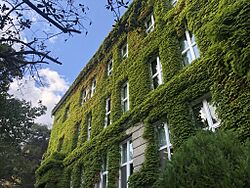
Mitchell Hall
Originally home to the school kitchens and dining room, the building was a gift from Miss Olivia E. Phelps Stokes, who donated US$100,000. A modest woman, she asked for the building to be named in memory of her friend, Sarah Lindlay Mitchell. Today, the building houses classrooms used primarily for mathematics lessons, the Math Department, the Sait Halman Computer Center, the teachers’ room, the audio-visual center, two Multimedia Rooms (MMRs), and a small English department office. The top floor, M400, is used for examinations, minor conferences, and weekly club sessions.
Woods Hall
Completed in 1914, the building was a partial gift from Mrs. Henry Woods of Boston, who donated US$58,000, with Helen Gould Shepard supplying the remaining US$25,000 required. It was used as a Science Building until 1990, and today is home to classrooms used primarily for English lessons, two English department offices, and two college counselling offices.
Sage Hall
A gift from Mrs. Margaret Olivia Sage, widow of Russell Sage, a famous 19th century financier and associate of Jay Gould, Sage Hall is one of the few buildings still used for its original purpose. A philanthropist, she donated US$100,000 for the building, built as a dormitory. Today, the building houses the girls' dormitories, infirmary, art studios and a darkroom.
Bingham Hall
Originally built as a medical school building, financed by William Bingham in memory of his mother, Mary Payne Bingham, the building housed the junior high school section from 1925 to 1992. Today, it is home to the boys' dormitories, as well as a secondary theater room, and business and administrative offices. A plaque commemorating the construction of the building, which reads “Mary Payne Bingham Hall, erected in honor of Mary Payne Bingham by her son William Bingham 2nd”, is visible above the front entrance.
Feyyaz Berker Hall
Feyyaz Berker Hall, colloquially referred to as "Feyyaz", today houses the science labs and classrooms, as well as the Science Department. The building was completed in 1990, and named after its largest donor, leading Turkish businessman and Robert College trustee, Feyyaz Berker (Robert College Eng '46 alumnus). The front of the building has arched windows, which mimic the façade of Gould Hall. Contents of the Biology Museum, which has one of the rarest collections in Turkey, are scattered across the second and third floors of the building.
Suna Kıraç Hall
A state-of-the-art theater building completed in 1990, including a large stage, make-up rooms, modern sound and lighting system and seating for 512 people, was named after its largest donor Suna Kıraç (American College for Girls '60 alumnus), a leading Turkish businesswoman and Robert College Trustee. Its basement houses the music department and several music rooms.
Nejat Eczacıbaşı Hall
The modern school gymnasium was opened in 1990 and named after its largest donor, prominent Turkish bio-chemist and businessman Dr. Nejat Eczacıbaşı (Robert College '32 alumnus). Its basement houses the Multi-Purpose Room (MPR), P.E. department offices, and the Cep (Turkish for “Pocket”), a student lounge area.
İbrahim Bodur Library
When founded in 1863, Robert College had four students. A sum of $2,120 had been allocated to the library, and Harvard University had donated 200 volumes for the opening of the library. During the 1950s and '60s, the college had one of the largest collections in Turkey. (In 1957: 111,598 books and 214 periodicals; the American College for Girls Library 27,163 books and 108 periodicals, according to the Turkiye Kütüphaneleri Rehberi (Turkish Libraries Guide) published by the Turkish National Library that year. After the foundation of Boğaziçi University, the college donated most of its collections to the newly founded university. Today, Robert College has a print collection of approximately 40,000 resources in both Turkish and English. It also has an expanding collection of eBooks, eMagazines and databases that can be accessed both on and off campus. The library went through an extensive renovation in 2014 and occupies an area of 1034 square meters, with a seating capacity of 290 people on the second and third floors of Gould Hall.
Other buildings and facilities
- The Rodney B. Wagner Memorial Maze
- Murat Karamancı Student Center (MKSC)
- Dave Phillips Field
- Konak Terrace
- Tennis courts
- Basketball courts
- Faculty housing (Barton House, White House, Blue House, Yalı, Guest House, and numerous other houses dispersed on campus)
- Green Tower
- The Bridge and Security
- Forum
Tuition and finances
Robert College's tuition fees, for the 2020–2021 academic year, are:
| Day Student | Boarder (5 days) | Boarder (7 days) |
|---|---|---|
| TRY 109,000 | TRY 149,300 | TRY 167,770 |
| US$14,750 | US$20,235 | US$22,735 |
Tuition fees are adjusted each year according to the inflation rates in a limited range set by the Ministry of National Education (MEB).
Robert College has consistently ranked as the most expensive high school in Turkey by tuition. According to school data, 26% of students received some form of financial aid for the 2019–2020 academic year.
Robert College files its taxes in New York State through two separate 501(c)(3) tax-exempt non-profit organizations: the Trustees of Robert College of Istanbul, tax-exempt since December 1947, and the Robert College Foundation, tax-exempt since May 2000. The data is publicly available on ProPublica. As of Fiscal Year 2017, the two organizations reported a combined revenue of 28.7 million USD.
Tuition fees and donations constitute a significant majority of the school's income. In 2019, income from tuition fees covered 55% of the school's expenses, with most of the remainder being supplied by donations. A majority of donors are alumni of the school, though financial institutions and corporations have donated as well.
Notable alumni
Since the Ottoman period, Robert College alumni have played a leading role in numerous fields including the arts, academia, science, engineering, business, civil society and government administration. Garnett stated in her 1904 publication that "since its foundation forty years ago many of its graduates have attained to high positions in the Governments of the Balkan principalities, and otherwise distinguished themselves." Three Robert College graduates were the representatives of their countries in the founding meeting of the United Nations held in San Francisco in March 1945: Nur al-Din Kahala for Syria, Hamiz Atif Kuyucak for Turkey and Dr. Shafaq for Iran.
In 1990, three alumni, Nejat Eczacıbaşı, Suna Kıraç and Feyyaz Berker donated the necessary funds for the construction of the new buildings that are mentioned in the Buildings section. An annual giving campaign raises funds for the school, as costs cannot be met by tuition fees alone. The development office publishes the RC Quarterly, which reaches 10,000 Robert College alumni around the world online and by mail.
Bizimtepe, a cultural and recreational center next to the campus, is an affiliate of the Alumni Association.
Notable former faculty
- Tevfik Fikret, Turkish poet, leader of the Servet-i Fünûn movement, founder of the modern school of Turkish poetry
- Cahit Arf, mathematician
- Hagop Vahram Çerçiyan, calligrapher and creator of Atatürk’s signature
- Calouste Gulbenkian, entrepreneur and art collector
- Behçet Kemal Çağlar, poet
- Stanwood Cobb, educator and author, founder of the Progressive Education Association
- Paul H. Dike, Professor of Physics
- John Freely, Professor of Physics, author
- Mebrure Gönenç, one of the first female members of the Turkish Parliament (alumna of the American College of Girls)
- Dimitri Gutas, Professor Emeritus of Arabic and Islamic Studies, Yale University, Arabist and Hellenist specialized in medieval Islamic philosophy.
- Frances Harshbarger, one of the first female American mathematicians to receive a doctorate
- Cem Karaca, musician
- Necip Fazıl Kısakürek, poet and author
- Paul Lange, conductor of the Ottoman Empire's Royal Orchestra, musician, father of US conductor Hans Lange
- M. M. Mangasarian, Armenian-American atheist and secularist intellectual
- Arman Manukyan, Professor of Economy and Accounting
- Mihri Pektaş, one of the first female members of the Turkish Parliament (alumna of the American College of Girls)
- Dave Phillips, physical education teacher, played professional basketball for Beşiktaş JK
- Mary Paton Ramsay, literary scholar
- Friedrich Schrader, German journalist and author
- Stefan Panaretov, Bulgarian diplomat, Special Envoy and Minister Plenipotentiary of Bulgaria to the U.S. (1914-1925), Bulgarian representative to League of Nations
- Karl von Terzaghi, Austrian civil engineer, known as the "father of soil mechanics and geotechnical engineering"
- Edgar Rose, German-American mechanical engineer, MS from MIT in one year. Designed and produced the first 2=stroke outboard tuned exhaust system at Kiekhaefer Mercury in 1958. Chief of stern drive and snowmobile engineering at Outboard Marine Corporation at different times after 1968, and VP of engineering before his retirement in 1990. Active as chief inspector at APBA OPC outboard races until ca. 2014.
See also
- Boğaziçi University
- Istanbul International Community School (former sister school)
- Education in the Ottoman Empire
- List of high schools in Turkey
- Koç School
- Üsküdar American Academy
Books on Robert College
- Ali Neyzi, Alma Mater and the Story of Robert College
- Asya Orhon, Kolejlerin Koleji, Robert Kolej
- Betty Tank, Pushing My Shadow
- Caleb Frank Gates, Not To Me Only, Princeton, 1940.
- Cyrus Hamlin, My Life and Times, Boston, 1893.
- Cyrus Hamlin, Among the Turks
- Eren Yanık, Akvaryum
via Internet Archive
- Hester Donaldson Jenkins, An Educational Ambassador to the Middle East
- John Freely, History of Robert College, Istanbul, YKY, 2000.
- Lynn Scipio, My Thirty Years in Turkey, New Hampshire, Ringde, 1955.
- Mary Mills Patrick, A Bosphorus Adventure, London, 1934.
- Mary Mills Patrick, Under Five Sultans
- May Fincancı, The Story of Robert College Old and New
- Moris Farhi, Young Turk
- Orhan Türker, Mega Revma'dan Arnavutköy'e, Istanbul, 2005
- Stevens Marcia & Malcolm, Against the Devil's Current: Life & Times of C.H.
- Talat S. Halman, Aklın Yolu Bindir, Istanbul, 2003.
- Ugur Ersoy, 1950–55 Erguvan Renkli Yıllar, Istanbul, 2004.


